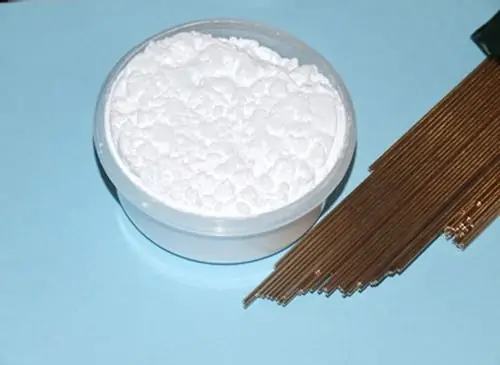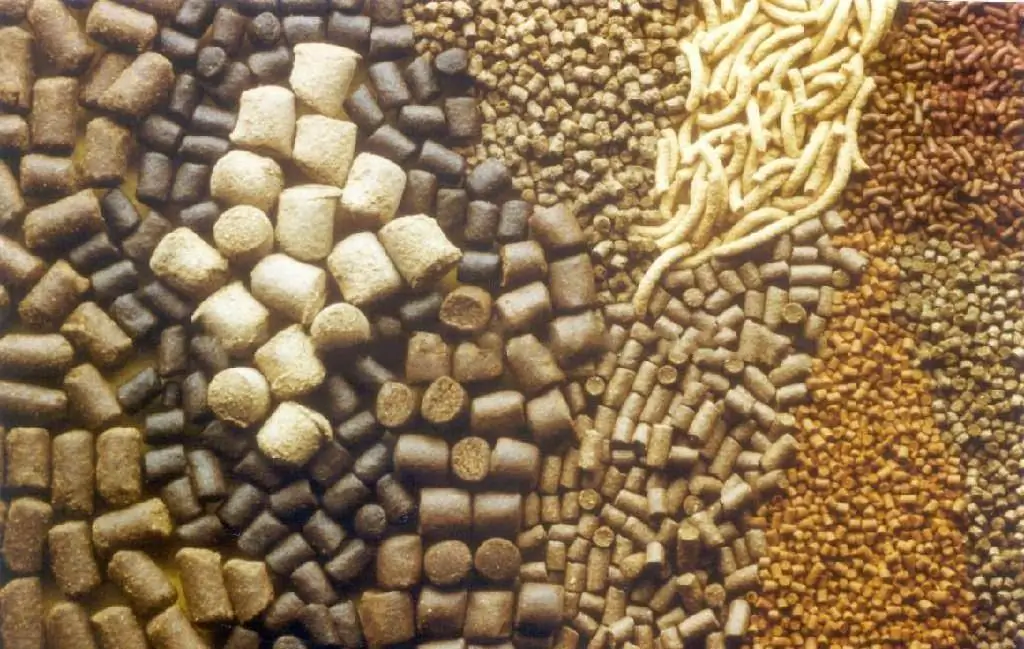2026 Author: Howard Calhoun | [email protected]. Last modified: 2025-01-24 13:10:31
One of the main conditions for the profitability of any livestock farm is the use of quality feed. The diet of both cattle and small cattle, pigs, poultry, etc. should be developed correctly. All feed used on farms is divided into three large categories: juicy, coarse and concentrated. Root crops and hay, of course, animals must receive. But to the greatest extent, the productivity of cattle, small cattle, pigs and poultry depends on how high-quality concentrated feed is used in their cultivation.
Definition
Those feeds are called concentrates, the percentage of nutrients in which is very high. In most cases, such food for animals is of plant origin. The feed of this variety is usually digested by 70-90%. Of course, their main advantage is a high degree of nutrition - 0.7-1.3 feed units.

Water in concentrates can contain up to 16%, and fiber - up to 15%. At the same time, such feeds, unfortunately, are poor in carotene, calcium and vitamin D. Concentrates contain quite a bit andvarious types of micronutrients. Such feed on farms, of course, should only be used in combination with juicy and rough.
Types of concentrates
All feeds of this variety used on livestock farms are classified primarily into two large groups:
- carbohydrate;
- protein.
Both of these concentrated feeds are an indispensable part of the diet of farm animals. They are used, of course, in poultry farms. The main value of carbohydrate concentrates is that they contain a large amount of starch. This substance in their composition can include up to 70%. The second type of concentrates, as its name already suggests, contains a lot of proteins - up to 20-25%.
In private households, farms and large livestock complexes, the following types of carbohydrate nutritious feed are most often used:
- oats;
- barley;
- wheat;
- millet;
- corn.
From protein concentrates, the most popular among farmers are:
- peas;
- soy.

Cake and meal also belong to the concentrated feed of this group. On farms, they can be part of the diet of almost any animal.
Combined concentrates are also very popular on farms. Such mixtures havebalanced composition, ideal for a particular type of agricultural animals. This type of concentrated feed is used on farms for cows, pigs, goats, sheep, poultry.
Cereals: composition and use
The most nutritious type of carbohydrate concentrate is corn. The nutritional value of such feed is 1.3 k / unit. At the same time, 1 kg of corn contains about 70 g of digestible protein, 2.5 g of phosphorus, 0.7 g of calcium. Some disadvantage of this type of concentrated feed is that the protein included in its composition is poor in lysine, methionine, tryptophan. Another disadvantage of corn is the impossibility of long-term storage. Animals are supposed to feed such grain in an unprocessed form for a maximum of 2 months from the date of harvest.
Barley is the most popular type of carbohydrate concentrate among farmers. In particular, such grain is widely used in pig and rabbit farms. The energy value of this concentrate is 1.15 q/u. At the same time, a kilogram of barley contains about 113 g of protein, 49 g of fiber, 485 g of starch.
Quite often wheat unsuitable for food purposes is also used for feeding agricultural animals. Such food is also considered very useful and nutritious. However, wheat is, unfortunately, somewhat more expensive than other types of concentrates. In terms of nutritional value, such grain is practically not inferior to corn (1.2 k / unit). At the same time, wheat contains more proteins than any other cereals - 133 g per kilogram. Use this concentrated food forCattle, small cattle, pigs. It is also very often introduced into the diet of agricultural poultry.

What other grains can be used
Such a carbohydrate concentrated feed as oats is valued by farmers primarily for its high fiber content. Its composition of this grain includes about 97 g per kilogram. That is, fiber in oats contains 2 times more than in barley. Protein in the composition of 1 kg of such grain includes 9-12%. Some disadvantage of this type of concentrate is that it contains 4-5% fatty acids, which adversely affect the quality of fat and meat. Most often, oats are introduced, of course, into the diet of horses. Sometimes they give such food to rabbits.
Another type of carbohydrate concentrate used on farms is rye. The composition of such grain is not much different from barley. However, rye, unfortunately, contains very small amounts of nitrogen-free extractives.
Bran
The most valuable type of carbohydrate concentrates are, of course, whole or crushed grains. However, such food is, unfortunately, quite expensive. Therefore, it is fed to animals on farms mixed with bran. The last type of concentrates is a common milling waste.
In terms of nutritional value, bran grain, of course, is somewhat inferior. However, they are richer in proteins, minerals, fats and B vitamins.
Bran used on farms can be barley, rye, oat, etc. However, the most popular among livestock breedersdeserved wheat feed of this variety.

Composition and use of bean concentrates
From the group of protein feeds, peas are most often introduced into the diet of animals on farms. The nutritional value of such a concentrate is about 1.19 k / unit. At the same time, 1 kg of peas contains 195 g of highly digestible protein and 54 g of fiber. In terms of the quality of the contained protein, this type of feed surpasses all concentrates used for growing animals. The use of peas allows not only to increase the productivity of cattle, small cattle, etc., but also significantly improve the quality of fat and meat.
A concentrate such as lupine is valued by farmers primarily for its very high percentage of protein content. The energy value of such feed is 1.1 k / unit. At the same time, lupine contains about 270 g of protein per kilogram. Only low alkaloid or non-alkaloid varieties of this crop are used in animal husbandry.
Meals and cakes
This type of protein concentrate is valued by farmers primarily for its high nutritional value. Both oilcake and oilseed meal are waste products from the oil industry. The first type of feed is obtained by pressing various kinds of seeds. Meal is made by extracting oil using a solvent.
About 2/3 of both of these types of food is made from sunflower seeds. Also, meal and cake can be cotton, hemp, corn, flax, etc. Such concentrates have a high nutritional value, but they still contain proteins.less than, for example, the same cereals.
In addition, when feeding cakes and meals to animals, certain rules should be observed. So, for example, cotton feed of this variety contains the poisonous substance gossypol, which can cause anemia. Flaxseed meal is valued by farmers for having a beneficial effect on the digestive system of animals. But at the same time, such food contains toxic glucosites. Both cotton concentrates and linen are fed to animals, thus only allowed in limited quantities.

Soybeans are considered the most nutritious type of meal and cake. These are the ones that contain the most protein. But unfortunately, soybeans are rarely grown in our country, of course. Livestock breeders on farms in Russia use, as already mentioned, mainly sunflower cake and meal. The energy value of such feed depends primarily on the content of the husk. According to the standards, it should not exceed 14% in oil cake and meal made from sunflower seeds.
Mixed feed
Concentrates of this variety are introduced into the diet of animals on farms very often. Compound feed is produced in Russia according to recipes approved by a single standard. The composition of such concentrates is developed primarily taking into account the fact that the finished product must have a high energy value. Also, the compound feed should ultimately contain the amount of biologically active substances, vitamins, carotene, antibiotics andetc. The nutritional value of concentrates of this variety depends both on the degree of their balance and on the quality of the components used in the manufacture.
Mixed feed can be prepared not only with the use of cereals and legumes. Often they are a mixture of concentrated and roughage. Also, in the manufacture of such a product, premixes, carbonic and sulphate s alts, food industry waste, yeast, dry whey, etc. are used.
Methods for processing concentrates
In Russia, feed of this variety is most often pre-crushed and then stored in farms or in elevators in a dry form. However, the following technologies can also be used to process concentrates in our country:
- yeast;
- m alting;
- extruding;
- micronization.

Crusher
Crushing concentrated feed is a must in most cases. The advantage of this processing method is, first of all, that when it is used, the hard shell of grain and beans is destroyed. And this, in turn, makes it easier for animals to chew the feed and increases the availability of the nutrients contained in it. The advantages of grinding include the fact that it is possible to give crushed milk to animals of almost all ages, even the smallest.
Matting
This processing method is also used in the production of concentrated feedquite often. In most cases, this technique is used to improve the taste of grain and, as a result, increase its absorption. During m alting, some of the starch in carbohydrate concentrates is converted to sugar.
Feed yeasting
This method allows, first of all, to increase the protein content in the diet of agricultural animals. In the process of yeasting, the concentrates are enriched with protein. The protein content in feed treated in this way can increase by 1.5-2 times. When using this method of processing farms get the opportunity to save 20-25% concentrates. In addition, feeding yeast feed has a beneficial effect on the he alth of animals and increases their productivity by 15-20%
Extruding
This type of processing allows you to transform the nutrient structure of concentrated feed. During extrusion, the physicochemical properties of proteins, starch, and fiber change for the better. In addition, when using this method, the sanitary condition of cereals and legumes improves.
In the process of preparing concentrated feed, in this case, the grain is subjected to various kinds of mechanical influences (friction, compression, etc.), moving from the high pressure zone to the atmospheric one. Feed treated in this way has a smell of baked bread and a very pleasant taste, and, therefore, is better eaten by animals.
Micronization
With this method, the feed is treated with infrared rays. As a result, inside the grains begin to vibrate intensely.starch molecules, which leads to the breakdown of this substance to sugars. After micronization, the feed is additionally subjected to conditioning and cooling. The use of such a concentrated feed for cattle, for example, can increase productivity by up to 12-15%.
Quality requirements
Of course, the animals on the farm are supposed to be offered exclusively high-quality concentrates. Grains and legumes should, for example, have their own color. Soaked concentrates of this variety lose their luster and become matte. At the same time, their feed value decreases.
The grains and legumes used on farms, among other things, must have a fresh (or barn after storage) smell. It is impossible to introduce into the diet of animals concentrates of this variety that are moldy or heated in heaps, as well as affected by pests. Grains and legumes used on farms should contain no more than 1-2%.

Approximately the same requirements are imposed on the quality of combined concentrated feed, meal and cake. These products must have their characteristic color and smell. The degree of grinding of the components of the combined concentrates must comply with the recipe and standards. The quality of such feed is determined taking into account the requirements of GOST 13496.
Recommended:
"Quality Circles" is a quality management model. Japanese "Quality Circles" and the possibilities of their application in Russia

Modern market economy requires companies to constantly improve their technological processes and staff training. Quality circles are a great way to involve active employees in the workflow and implement the most productive ideas in the enterprise
Feed nutrition: quality indicators and energy value assessment

The diet for farmed animals should be developed as balanced as possible. To ensure high productivity in farms, it is imperative to assess the quality and nutritional value of feed
What is the difference between the cadastral value and the inventory value? Determination of the cadastral value

Recently real estate has been valued in a new way. The cadastral value was introduced, providing for other principles for calculating the value of objects and as close as possible to the market price. At the same time, the innovation led to an increase in the tax burden. The article describes how the cadastral value differs from the inventory value and how it is calculated
Flux for welding: purpose, types of welding, flux composition, rules of use, GOST requirements, pros and cons of application

The quality of the weld is determined not only by the ability of the master to organize the arc correctly, but also by the special protection of the working area from external influences. The main enemy on the way to creating a strong and durable metal connection is the natural air environment. The weld is isolated from oxygen by a flux for welding, but this is not only its task
How to feed horses: types of feed, nutritional rules and diet

To figure out what to feed horses, it would not hurt to find out how these animals eat in the wild. In ancient times, herds of horses simply grazed in the meadows. This was enough to provide their body with all the necessary nutrients

